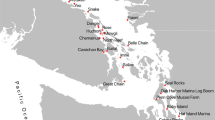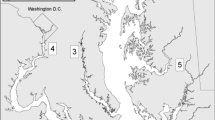Abstract
Grey seal (Halichoerus grypus) populations declined dramatically in U.S. waters during the nineteenth and twentieth centuries, but have rebounded in recent decades as a result of legal protection. In the Gulf of Maine, increasing grey seal populations have the potential to impact commercially important groundfish species such as cod and haddock, but the potential also exists for more complex ecological interactions to occur given the recent increase of spiny dogfish (Squalus acanthias), another potential groundfish predator. Specifically, seal predation on dogfish could free groundfish species from additional predation pressure. Little quantitative data exists on intraguild predation rates by grey seals on spiny dogfish, in part because of the limitations of current methods of food habits analysis for grey seals. We report the development, validation, and field testing of a non-invasive genetic method for the detection of spiny dogfish in grey seal diets using DNA collected from seal feces. Our method amplified spiny dogfish DNA from 10 of 10 positive control scats from a captive seal with a known diet, and amplified spiny dogfish DNA from 0 of 10 negative control scats. We field tested the method on 20 scats from wild seals and detected spiny dogfish in two of the samples. All positive amplifications were sequenced to verify the species identify, and all were spiny dogfish. Our method has the potential to provide valuable information about changing predator prey dynamics in the Gulf of Maine and elsewhere.
Similar content being viewed by others
References
Ampela K (2009) The diet and foraging ecology of gray seals (Halichoerus grypus) in United States waters. Dissertation, City University of New York, USA
Beck CA, Iverson SJ, Bowen W, Blanchard W (2007) Sex differences in grey seal diet reflect seasonal variation in foraging behaviour and reproductive expenditure: evidence from quantitative fatty acid signature analysis. J Anim Ecol 76(3):490–502
Bowen WD (2000) Reconstruction of pinniped diets: accounting for complete digestion of otoliths and cephalopod beaks. Can J Fish Aquat Sci 57(5):898–905
Bowen WD, Iverson SJ (2013) Methods of estimating marine mammal diets: a review of validation experiments and sources of bias and uncertainty. Mar Mammal Sci 29(4):719–754
Bowen WD, Lawson JW, Beck B (1993) Seasonal and geographic variation in the species composition and size of prey consumed by grey seals (Halichoerus grypus) on the Scotian Shelf. Can J Fish Aquat Sci 50(8):1768–1778
Byron C, Morgan A (2016) Potential role of spiny dogfish in gray and harbor seal diets in the Gulf of Maine. Mar Ecol Prog Ser 550:249–270
Deagle BE, Tollit DJ, Jarman SN, Hindell MA, Trites AW, Gales NJ (2005) Molecular scatology as a tool to study diet: analysis of prey DNA in scats from captive Steller sea lions. Mol Ecol 14(6):1831–1842
Gruber CP (2014) Social, economic, and spatial perceptions of gray seal (Halichoerus grypus) interactions with commercial fisheries in Cape Cod, MA. Dissertation, Duke University, Durham, North Carolina, USA
Hall TA (1999) BioEdit: a user-friendly biological sequence alignment editor and analysis program for Windows 95/98/NT. Nucleic Acids Symp Ser 41:95–98
Harvey JT (1989) Assessment of errors associated with harbour seal (Phoca vitulina) faecal sampling. J Zool 219:101–111
Jefferson TA, Webber MA, Pitman RL, Gorter U (2015) Marine mammals of the world: a comprehensive guide to their identification, 2nd edn. Elsevier, New York
Jobling M, Breiby A (1986) The use and abuse of fish otoliths in studies of feeding habits of marine piscivores. Sarsia 71(3–4):265–274
Kunkel KE, Mech LD (1994) Wolf and bear predation on white-tailed deer fawns in northeastern Minnesota. Can J Zool 72(9):1557–1565
Larkin MA, Blackshields G, Brown NP, Chenna R, McGettigan PA, McWilliam H, Valentin F, Wallace IM, Wilm A, Lopez R, Thompson JD, Gibson TJ, Higgins DG (2007) Clustal W and clustal X version 2.0. Bioinformatics 23(21):2947–2948
Lelli B, Harris DE (2006) Seal bounty and seal protection laws in Maine, 1872 to 1972: historic perspectives on a current controversy. Nat Resour J 46(4):881–924
Lelli B, Harris DE, Aboueissa AM (2009) Seal bounties in Maine and Massachusetts, 1888 to 1962. Northeast Nat 16(2):239–254
Masland EDP, Sweezy MA, Ono KA (2010) Molecular methods for differentiating grey seal (Halichoerus grypus) and harbour seal (Phoca vitulina) scat. Mol Ecol Res 10(1):214–217
Matejusová I, Bland F, Hall AJ, Harris RN, Snow M, Douglas A, Middlemas SJ (2013) Real-time PCR assays for the identification of harbor and gray seal species and sex: a molecular tool for ecology and management. Mar Mammal Sci 29:186–194
Morgan AC, Sulikowski JA (2015) The role of spiny dogfish in the northeast United States continental shelf ecosystem: how it has changed over time and potential interspecific competition for resources. Fish Res 167:260–277
Murie DJ, Lavigne DM (1986) Interpretation of otoliths in stomach content analyses of phocid seals: quantifying fish consumption. Can J Zool 64(5):1152–1157
Phillips EM, Harvey JT (2009) A captive feeding study with the Pacific harbor seal (Phoca vitulina richardii): implications for scat analysis. Mar Mamm Sci 25(2):373–391
Polis GA, Myers CA, Holt RD (1989) The ecology and evolution of intraguild predation: potential competitors that eat each other. Ann Rev Ecol Syst 20:297–330
Pompanon F, Deagle BE, Symondson WO, Brown DS, Jarman SN, Taberlet P (2012) Who is eating what: diet assessment using next generation sequencing. Mol Ecol 21(8):1931–1950
Rago P, Sosebee K (2013) Update on the status of spiny dogfish in 2015 and projected harvests at the FMSY proxy and Pstar of 40%. Northeast Fisheries Science Center, Woods Hole
Rasmussen AS, Arnason U (1999) Phylogenetic studies of complete mitochondrial DNA molecules place cartilaginous fishes within the tree of bony fishes. J Mol Evol 48(1):118–123
Reed JZ, Tollit DJ, Thompson PM, Amos W (1997) Molecular scatology: the use of molecular genetic analysis to assign species, sex and individual identity to seal faeces. Mol Ecol 6:225–234
Tamura K, Stecher G, Peterson D, Filipski A, Kumar S (2013) MEGA6: molecular evolutionary genetics analysis version 6.0. Mol Biol Evol 30(12):2725–2729
Villesen P (2007) FaBox: an online toolbox for fasta sequences. Mol Ecol Notes 7(6):965–968
Waits LP, Paetkau D (2005) Noninvasive genetic sampling tools for wildlife biologists: a review of applications and recommendations for accurate data collection. J Wildl Manag 69(4):1419–1433
Waring GT, Josephson E, Maze-Foley K, Rosel PE (2016) US Atlantic and Gulf of Mexico marine mammal stock assessments -- 2015. NOAA Technical Memorandum NMFS-NE-238
Ye J, Coulouris G, Zaretskaya I, Cutcutache I, Rozen S, Madden T (2012) Primer-BLAST: a tool to design target-specific primers for polymerase chain reaction. BMC Bioinform 13:134
Zeale MR, Butlin RK, Barker GL, Lees DC, Jones G (2010) Taxon-specific PCR for DNA barcoding arthropod prey in bat faeces. Mol Ecol Resour 11(2):236–244
Acknowledgements
The University of New England provided financial support to the project in the form of a mini-grant awarded to KAO and ZHO. In addition, we thank the Sulikowski Lab at the University of New England for providing tissue samples and two anonymous reviewers for helpful comments on an earlier draft of this manuscript.
Author information
Authors and Affiliations
Contributions
KO and ZHO designed the study and wrote the manuscript. CS, AC, MS, AB, MD, KG, JA, and ZHO conducted laboratory analyses.
Corresponding author
Rights and permissions
About this article
Cite this article
Ono, K.A., Steinbeiser, C.M., Coco, A.B. et al. Detecting spiny dogfish in grey seal diets. Conservation Genet Resour 11, 481–485 (2019). https://doi.org/10.1007/s12686-018-1044-x
Received:
Accepted:
Published:
Issue Date:
DOI: https://doi.org/10.1007/s12686-018-1044-x




